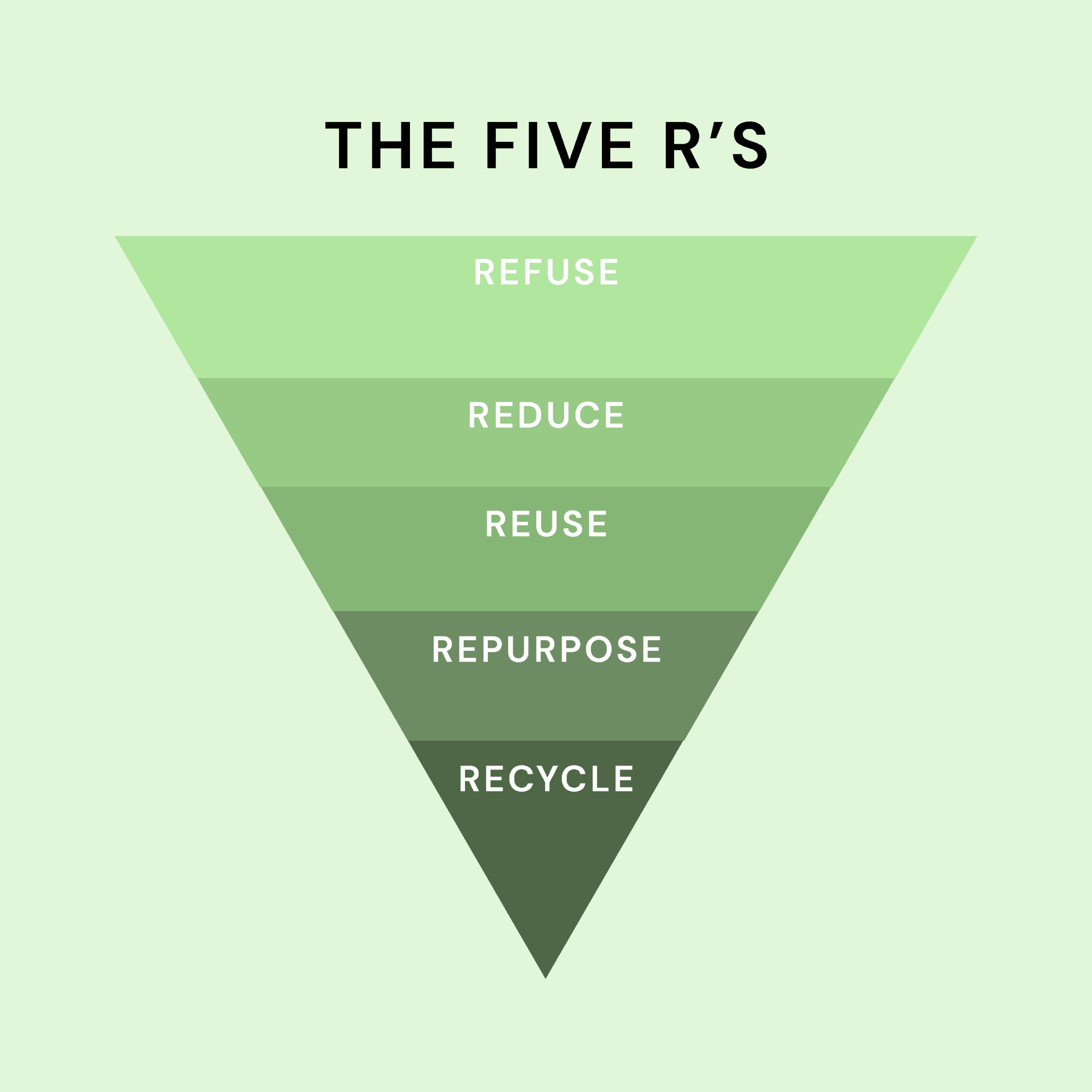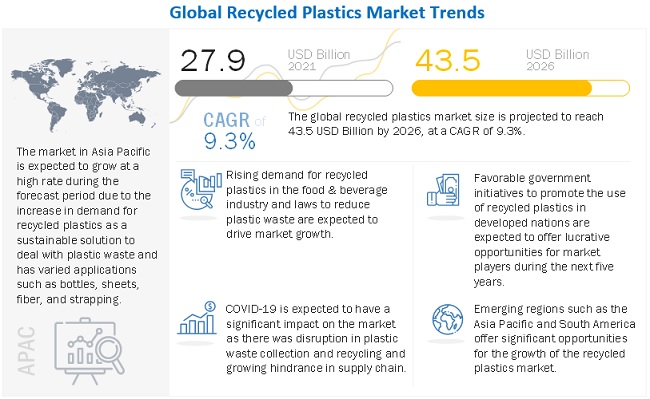Environment
'Busting myths about plastic recycling': everything you need to know
- Achint
- July 10, 2022
You must have heard about the 3Rs in middle school, which taught us how to reduce, reuse and recycle. The concept of 3R’s was initially introduced by Pollution Probe in 1975. Pollution Probe is one of Canada’s first NGOs.
Then came the 5R’s: Refuse, Reduce, Reuse, Repurpose and Recycle. While comparing the two models, I was struck by how ‘Recycle’ is positioned at the bottom as a last resort. Isn’t it intriguing? We’ve heard for a long time how beneficial recycling is, and we agree. But first, let’s consider why recycling is the last choice and debunk some fallacies about it.

Recycling, to put it simply, is the process of taking wasted materials and transforming them into something useful.
Recycling anything that may be recycled is one of the key ways we continue to make attempts to be more ecologically responsible. For example, check out this beneficial research of putting rubber from old tires to asphalt, which provided additional sun protection, thereby helping roads to survive up to twice as long before splitting.
Why is it a mainstream practice if it is at the bottom of the Pyramid and scientists have identified it as a last resort to waste management? Let’s look at it.
Let’s take a closer look at the term cycle and how it refers to recycling. The entire recycling process begins with the treatment and transformation of clean and dry recyclable materials such as plastic bottles, cans, paper, and cardboard into other useful materials such as sheets, chairs, and so on.
Several studies have found that using waste and repurposed materials has a positive influence on a variety of levels. This includes industry’s sustainability through cost reductions, acting as a feasible solution to environmental concerns, and minimizing the use of raw materials, reducing the demand for natural resources. However, we can only complete the cycle if we use recycled products. This refers to following a circular economy model.

This research talked about how the circular economy is a new business strategy that aims to promote resource efficiency through product reconstruction, resulting in more sustainable growth. However, we are still seeing a lot of material going to waste.
This raises a question.
To put it bluntly, we need recycling because we aren’t refusing, reducing, reusing, or repurposing the items we don’t need. A product’s life cycle looks like purchase, use, and trash. This straight line accumulates in landfills, adding to the heaps of rubbish already present.

Recyclable materials such as plastics, books, and wood should be purchased according to need, reused instead of buying trends, repurposing for different purposes, and lastly, recycled when nothing else is available.
Apart from the above-mentioned, recycling is an excellent way to lessen the amount of garbage we send to landfills and incinerators. It reduces pollution, conserves natural resources, and conserves energy. Most crucially, it prohibits us from discarding our trash in countries with laxer waste laws and procedures. Read our article on composting.
Get on step closer to making eco-friendly choices
Well, now we know that recycling, though least preferred but an important pillar of the circular economy. Considering the current waste accumulated in our landfills and the materials we use, recycling is the way to bring this discarded waste back to the economy.
A Natgeo study showed that a whopping 91% of plastics are not getting recycled.
But with all the efforts going around the world and the technology evolving, why is it still not mainstream? Where is it failing? I’ve tried to give my 5 top reasons:
Let’s start with the main perpetrator. Plastics accounted for nearly 18 per cent of the 146.1 million tons of landfills ill in 2018. Yet, in the same year, plastic recycling contributed to only 4.47 per cent of the 69 million tons of recyclable municipal waste (source).
Most of our plastic ends up in landfills, oceans, waterbodies, soil, and our bodies. Many people believe that only certain types of plastic are recyclable. However, to some extent, all sorts of polymers are recyclable. Virgin plastics can be recycled and used at least 4-5 times before they degrade when compared to multi-layered plastics (MLP).
The main problem with plastics, though, is their composition. Different types of plastics have different melting points. Making it harder to recycle. Another problem is that it is often mixed with other waste like food, chemicals, etc. That is because 40% of plastic is used for packaging. Resulting in cleaning the plastics harder, which is an essential step before recycling.
Dirty plastics can not be recycled
National geographic Tweet
Another reason that recycling is failing is that the circular process is not completed. This could happen for a variety of reasons. First is the unavailability of recycling and refurbishing services. With the combination of plastics in our consumer ecosystem, it is hard to find one vendor that fits it all.
Multiple vendors have different plastic recycling units. As a consumer, we lack awareness and education on types of plastic recycling. Finding such providers in remote places gets even more brutal.

A team of Nepalese hikers in 2020 spent 47 days gathering and removing over 2.2 tons of trash from Mount Everest base camp. In 2019, the garbage collected amounted to 10 tons, requiring a six-week operation to clear out.
Startups like RecoSolution, which aims to bridge the gap between the need for recycling and availability, help remote areas to be equally equipped with recycling facilities. Such startups aim to complete the circular process by encouraging users to purchase remanufactured products and practice sustainability.
Another reason for the failure of the circular cycle is people’s mistrust of recycled products. Because recycled items are typically seen as secondhand, some clients perceive that using them poses a risk and that their value is inferior to that of the original product. The advantages of using them are limited. Furthermore, some buyers have a hostile personal perception and lack trust in these products.
But the good news is that the plastic recycling market is showing great promises and is expected to rise at 9.3% CAGR and be projected to reach $41.6 Billion by 2026. Read the report here.

Find out how RecoSolution is planning to deal with this issue in our next article.
According to Draft Plastic Waste Management Rules, 2016 MLP can be defined as (read the report by Down to earth, here):
Any material used or to be used for packaging and having at least one layer of plastic as the main ingredient in combination with one or more layers of material such as paper, paperboard, polymeric material, metalised layers or aluminium foil, either in the form of laminate or co-extruded structure.
Several items are made so that it is hard to disentangle and recycle the plastic content. These are generally multi-layered plastic, typically seen in chip wrappers made of aluminium, plastic, or tetra packs. Different types of plastic can be blended, or additional materials such as adhesive and metal bolts can be glued or attached to the plastic.
In MLP, the layers are formed by coextrusion, lamination, or various coating technologies. As a result, combining it with other materials makes recycling more challenging, as well as lengthening the time and expense involved. (source: wiki)
Lastly, the most important reason for failure in recycling is consumers not understanding the basics of plastics. Plastics producers and enterprises continue to generate single-use plastics and package items without the fear of retaliation.
90% people aware of harmful effects of plastic bags, but still use it: Study
Economic Times Tweet
Apart from that, everyone must keep track of their recycling manners. Lack of education on segregation leads to contamination of recycling bins with food waste and recyclables. In addition, many nations have made it illegal to use single-use plastics and other similar products. These are positive first steps toward a full-fledged plastics-free future.
Do we even know the difference between compostable and biodegradable plastics? Read our blog on ‘compostable plastics: truth or myth?‘
These layers are not visible to the naked eye, making it difficult to understand that the product cannot be recycled as is.
National Georaphic Tweet
The need for recycling should only arise when one cannot refuse, reduce, reuse or repurpose. This goes for all individuals and enterprises. Less use of harmful and non-recyclable materials should be condensed, which will only lead to a sustainable future. If we keep producing more plastic and recycling it, more plastic will be injected and reused.
Our overall goal should be to reduce the use of non-recyclables and solve the problem of recycling which will allow individuals to keep a check on how their waste can turn into something fruitful.
This brings us to the article’s title, which evokes us to choose between materialism and minimalism. Living with a minimum ecological footprint and making educated choices as an individual will allow us to cut down the extra material and focus on what is absolutely necessary.
Read how Mr. Ashish Agrawal is living a meaningful life with a mindful consumption method.
When the boat is sinking, repairing the hole is more effective than emptying the water with a bucket.